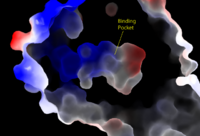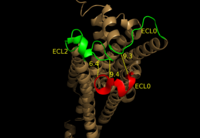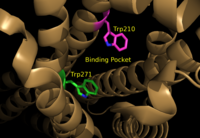Sandbox Reserved 1172
From Proteopedia
(Difference between revisions)
| Line 18: | Line 18: | ||
| - | == Disease Relevance == | ||
| - | Because LPA<sub>1</sub> is expressed in so many tissues throughout the body, it has been linked to the symptoms and progression of several different diseases and disorders. For example, due to LPA<sub>1</sub>'s role in pain signaling, overexpression of this protein can cause both [https://en.wikipedia.org/wiki/Allodynia allodynia] or [https://en.wikipedia.org/wiki/Hyperalgesia hyperalgesia], common symptoms of multiple sclerosis or strokes. In addition, since LPA<sub>1</sub> helps in the myelination of Schwann cells, mutation of the receptor can also lead to a decrease in [https://en.wikipedia.org/wiki/Prepulse_inhibition prepulse inhibition], a general sign of schizophrenia.<ref name="number6">PMID: 20331961</ref>.Lastly, because of the mitogen signaling activity of LPA<sub>1</sub>, abnormal expression or mutation of this receptor has been linked to tumor growth, survival, and migration in both liver and lung tumors. As recently discussed, the His40 on LPA<sub>1</sub>, when protonated, increased LPA binding affinity is increase by up to 1kcal/mol. Because of this, in an acidic environment that is typically produced by [https://en.wikipedia.org/wiki/Tumor_hypoxia hypoxic tumors] creating lactic acid, LPA<sub>1</sub> activity is increased, allowing these tumors to continue to proliferate, migrate, and survive.<ref name="number7">PMID: 24367336</ref>. In contrast, the LPA<sub>1</sub> receptor has also been found to induce protective functions in the presence of a particular illness. For example, in patients with heart disease, LPA<sub>1</sub> has been found to communicate with [[PI3K]], [https://en.wikipedia.org/wiki/Protein_kinase_B PKB], and [[ERK]] to create a hypertrophic response in the heart in order to offset reduced heart contractions. | ||
== Receptor Comparison == | == Receptor Comparison == | ||
| Line 35: | Line 33: | ||
A model for lipid agonist binding generated through molecular modeling was used to dock two of the cannabinoid receptor CB<sub>1</sub>'s most abundant endogenous ligands into the LPA<sub>1</sub> binding pocket. <ref name="regpeps">PMID: 26091040</ref> Rotameric shifts of Trp210 and Trp271 leading to expansion of the binding pocket and the exposure of the π clouds of their indole rings provided favorable interactions with the double bonds of the phosphorylated cannabinoid ligands. This favorable binding provides evidence that the hydrophobic binding pockets of LPA<sub>1</sub> and CB<sub>1</sub> are able to favorably bind the same poly-unsaturated acyl chains with metabolically interconvertible head groups. <ref name="regpeps">PMID: 26091040</ref> | A model for lipid agonist binding generated through molecular modeling was used to dock two of the cannabinoid receptor CB<sub>1</sub>'s most abundant endogenous ligands into the LPA<sub>1</sub> binding pocket. <ref name="regpeps">PMID: 26091040</ref> Rotameric shifts of Trp210 and Trp271 leading to expansion of the binding pocket and the exposure of the π clouds of their indole rings provided favorable interactions with the double bonds of the phosphorylated cannabinoid ligands. This favorable binding provides evidence that the hydrophobic binding pockets of LPA<sub>1</sub> and CB<sub>1</sub> are able to favorably bind the same poly-unsaturated acyl chains with metabolically interconvertible head groups. <ref name="regpeps">PMID: 26091040</ref> | ||
[[Image:TrpRotamericShiftsCM.png|200 px|left|thumb|Figure 1: Electrostatic illustration of the amphipathic binding pocket of the LPA<sub>1</sub> receptor. This binding pocket, located in the interior of the protein, has both polar and nonpolar regions. The blue and red coloration highlight the positively and negatively charged regions, respectively, and the white color shows the nonpolar region of the binding pocket.]] | [[Image:TrpRotamericShiftsCM.png|200 px|left|thumb|Figure 1: Electrostatic illustration of the amphipathic binding pocket of the LPA<sub>1</sub> receptor. This binding pocket, located in the interior of the protein, has both polar and nonpolar regions. The blue and red coloration highlight the positively and negatively charged regions, respectively, and the white color shows the nonpolar region of the binding pocket.]] | ||
| + | |||
| + | == Disease Relevance == | ||
| + | Because LPA<sub>1</sub> is expressed in so many tissues throughout the body, it has been linked to the symptoms and progression of several different diseases and disorders. For example, due to LPA<sub>1</sub>'s role in pain signaling, overexpression of this protein can cause both [https://en.wikipedia.org/wiki/Allodynia allodynia] or [https://en.wikipedia.org/wiki/Hyperalgesia hyperalgesia], common symptoms of multiple sclerosis or strokes. In addition, since LPA<sub>1</sub> helps in the myelination of Schwann cells, mutation of the receptor can also lead to a decrease in [https://en.wikipedia.org/wiki/Prepulse_inhibition prepulse inhibition], a general sign of schizophrenia.<ref name="number6">PMID: 20331961</ref>.Lastly, because of the mitogen signaling activity of LPA<sub>1</sub>, abnormal expression or mutation of this receptor has been linked to tumor growth, survival, and migration in both liver and lung tumors. As recently discussed, the His40 on LPA<sub>1</sub>, when protonated, increased LPA binding affinity is increase by up to 1kcal/mol. Because of this, in an acidic environment that is typically produced by [https://en.wikipedia.org/wiki/Tumor_hypoxia hypoxic tumors] creating lactic acid, LPA<sub>1</sub> activity is increased, allowing these tumors to continue to proliferate, migrate, and survive.<ref name="number7">PMID: 24367336</ref>. In contrast, the LPA<sub>1</sub> receptor has also been found to induce protective functions in the presence of a particular illness. For example, in patients with heart disease, LPA<sub>1</sub> has been found to communicate with [[PI3K]], [https://en.wikipedia.org/wiki/Protein_kinase_B PKB], and [[ERK]] to create a hypertrophic response in the heart in order to offset reduced heart contractions. | ||
</StructureSection> | </StructureSection> | ||
== References == | == References == | ||
<references/> | <references/> | ||
Revision as of 13:24, 12 April 2016
| This Sandbox is Reserved from Jan 11 through August 12, 2016 for use in the course CH462 Central Metabolism taught by R. Jeremy Johnson at the Butler University, Indianapolis, USA. This reservation includes Sandbox Reserved 1160 through Sandbox Reserved 1184. |
To get started:
More help: Help:Editing |
Lysophosphatidic Acid Receptor 1
References
- ↑ 1.00 1.01 1.02 1.03 1.04 1.05 1.06 1.07 1.08 1.09 1.10 1.11 Chrencik JE, Roth CB, Terakado M, Kurata H, Omi R, Kihara Y, Warshaviak D, Nakade S, Asmar-Rovira G, Mileni M, Mizuno H, Griffith MT, Rodgers C, Han GW, Velasquez J, Chun J, Stevens RC, Hanson MA. Crystal Structure of Antagonist Bound Human Lysophosphatidic Acid Receptor 1. Cell. 2015 Jun 18;161(7):1633-43. doi: 10.1016/j.cell.2015.06.002. PMID:26091040 doi:http://dx.doi.org/10.1016/j.cell.2015.06.002
- ↑ Hernández-Méndez, Aurelio, Rocío Alcántara-Hernández, and J. Adolfo García-Sáinz. "Lysophosphatidic Acid LPA1-3 Receptors: Signaling, Regulation and in Silico Analysis of Their Putative Phosphorylation Sites." Receptors & Clinical Investigation Receptor Clin Invest 1.3 (2014). Web. 15 Feb. 2016.'
- ↑ Yung, Y. C., N. C. Stoddard, and J. Chun. "LPA Receptor Signaling: Pharmacology, Physiology, and Pathophysiology." The Journal of Lipid Research 55.7 (2014): 1192-214. Web. 17 Feb. 2016.'
- ↑ Chun, J., Hla, T., Spiegel, S., and Moolenaar, W.H. “Lysophospholipid Receptors: Signaling and Biochemistry.” John Wiley & Sons, Inc. (2013) pp.i-xviii. 5 Feb. 2016.'
- ↑ Anliker B, Choi JW, Lin ME, Gardell SE, Rivera RR, Kennedy G, Chun J. Lysophosphatidic acid (LPA) and its receptor, LPA1 , influence embryonic schwann cell migration, myelination, and cell-to-axon segregation. Glia. 2013 Dec;61(12):2009-22. doi: 10.1002/glia.22572. Epub 2013 Sep 24. PMID:24115248 doi:http://dx.doi.org/10.1002/glia.22572
- ↑ Chun, E., Thompson, A.A., Lui, W., Roth, C.B., Griffith, M.T., Katritch, V., Kunken, J., Xu, F., Cherezov, V., Hanson, M.A., and Stevens, R.C. “Fusion partner tool chest for the stabilization and crystallization of G protein-coupled receptors.” Structure 20, (2012) 967-976.'
- ↑ Van Durme, J., Horn, F., Costagliola, S., Vriend, G., and Vassart, G. “GRIS: glycoprotein-hormone receptor information system.” Mol. (2006) Endocrinol. 20, 2247-2255'
- ↑ Lin ME, Herr DR, Chun J. Lysophosphatidic acid (LPA) receptors: signaling properties and disease relevance. Prostaglandins Other Lipid Mediat. 2010 Apr;91(3-4):130-8. doi:, 10.1016/j.prostaglandins.2009.02.002. Epub 2009 Mar 4. PMID:20331961 doi:http://dx.doi.org/10.1016/j.prostaglandins.2009.02.002
- ↑ Justus CR, Dong L, Yang LV. Acidic tumor microenvironment and pH-sensing G protein-coupled receptors. Front Physiol. 2013 Dec 5;4:354. doi: 10.3389/fphys.2013.00354. PMID:24367336 doi:http://dx.doi.org/10.3389/fphys.2013.00354



